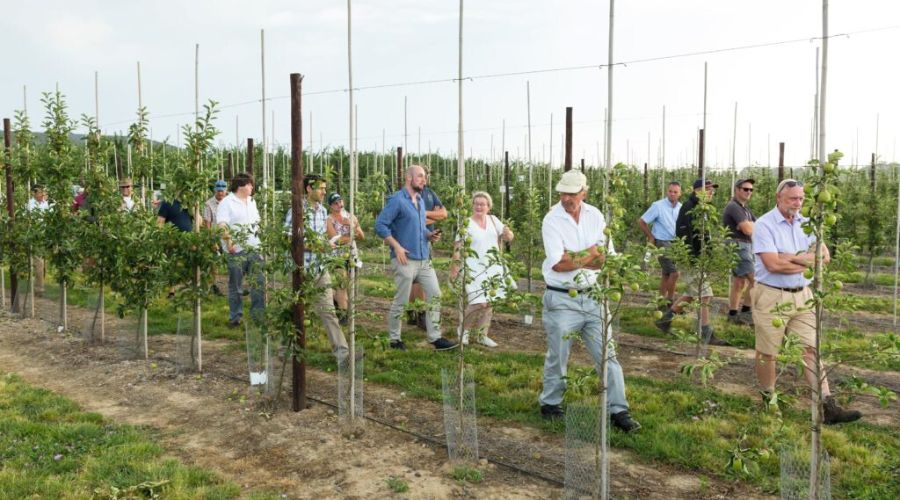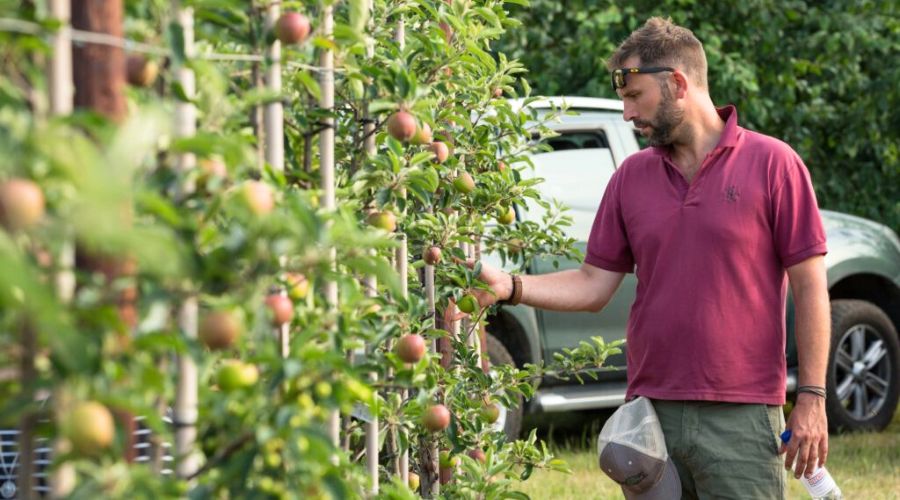Trials launched to look for new solutions that can boost orchard productivity
8th August 2024
Sensors that can “listen” to electrical impulses in trees, low-cost growing systems, the latest technology and techniques for improving orchard productivity were some of the topics discussed at the Hutchinsons Helios trials site at Newent, Gloucestershire.

The 10-year Helios project, launched in 2017, has been investigating whether canopies and tree architecture can be redesigned to intercept more light and improve yields in a cost-effective way.
Two orchards of Gala Galaxy clones on different rootstocks have been established, one in Gloucestershire, and the other in Kent, featuring a range of different planting systems.
One planting configuration that has stood out in the trials so far is the Gala on M116 rootstock with minimal support – no post and wire system, just a simple wire attached at planting.
Helios project
Hutchinsons agronomist Nigel Kitney said: “Over the seven years of Helios work to date, the M116 minimal support system has proven to be the most profitable, with the highest internal rate of return on investment.
“On a heavy soil you probably wouldn’t plant M116, but on our sandy loam, we can control the vigour, and it’s performed really well.”
Running alongside Helios, Hutchinsons is also involved with several innovative research projects that aim to drive orchard management forward using cutting-edge tools and techniques, including ways to improve control of common diseases such as scab and canker, and build sustainability.
Growers attending July’s open day at the Gloucestershire site received an update on these projects.
IRIS trial
One of the discussed projects was the Hutchinsons Improving Resilience In Scab control (IRIS) trial, running in a 1ha orchard of Gala on the M116 minimal support system.
The IRIS trial aims to improve the resilience of scab fungicide programmes in the face of a diminishing fungicide armoury.
It is investigating whether biostimulant products can help trees withstand disease and fill ‘gaps’ in spray programmes by triggering systemic acquired resistance (SAR).
Twenty-two different treatments were tested this season, with varying results, although some did show an excellent reduction in scab incidence, Mr Kitney said.
“Phosphites, for example, have proven very useful for reducing scab, however, their use must not be overdone, as some yellowing of extension growth was seen earlier this year where one phosphite product had been used for multiple applications,” he added.
Spore detection
Part of the concept behind IRIS is that biostimulants should be deployed when there is good leaf canopy, after starting the season with conventional fungicides, and then only use fungicides if the RIMpro scab prediction model exceeds a set threshold.
However, Mr Kitney said that there had been periods this year when the RIMpro model had overestimated scab risk at the start of the season and underestimated it later in the year, raising some questions over its accuracy.
This year, Hutchinsons is working with Optisense and Newcastle University to develop a novel system that can detect spores in the orchard to see how it correlates with RIMpro predictions.
The system uses a specifically designed cyclone air sampler (similar to a Dyson vacuum cleaner) to “suck” spores from the air and collect them on rotating rods.
DNA from these samples is then analysed using a LAMP test (Loop-mediated isothermal amplification) to identify the type of spores present.
Currently this is done in the lab, but Mr Kitney said the aim was to develop a fully automated system capable of doing everything in the field and send results directly to the grower to provide early disease warnings.
This season, 40 devices are being trialled in cider and dessert orchards in the West Midlands and Kent, plus another eight in vineyards.
“Our focus is currently on identifying the correlation between the sensors and RIMpro modelling, and also to identify where in the orchard they are best positioned.
Mr Kitney said: “Historically, spore testing has been possible, but it was very labour intensive. This DNA-based system could revolutionise that. We’re focussing on scab, but it could be used to detect any other ascospores in the air, such as Downy mildew.”

Improving scab control
Another project borne out of IRIS was the Canker Reduction in Apple Fruit Trees (CRAFT) trial, which is currently in its second year.
This is investigating whether different elicitor products, growth regulators, foliar feeds or biological fungicides can be used to bolster the natural defences of apple trees to infection by the Neonectria ditissima fungus, responsible for causing canker formation.
The trial is being hosted at a site in the West Midlands, close to the Helios West project, deliberately chosen for its high apple canker risk.
Many of the products being tested are the same as in IRIS, plus a few new options, Mr Kitney explained.
“Three or four products appeared particularly useful in helping the trees resist canker, where we noted statistically significant reductions in the occurrence of the disease following their use, which is really quite exciting. One in particular looks very promising, reducing canker from 4.8 to 0.3 new infections per 100 shoots, for a relatively low cost of just £30/ha.
“There’s already another product from our IRIS trial that is going through the EAMU process at the moment, so it really shows the wider benefits of doing trials such as this. It’s really exciting to be moving things forward and getting some useful new options for growers out of the work we’re doing.
“As we continue to loose tools in the form of crop protection products for the future, the more different options we can find that nudge us in the right direction, the better. Each on their own may not necessarily give 100% control, but if you can stack different options together, they can help to overcome barriers,” he continued.
Mapping variability
Growers were also introduced to the Innovate UK-funded Precision Orchard Management for Environment (POME) project, which seeks to map orchard variability or detect disease with sensors, enabling variable rate application of thinners, growth regulators and plant protection products.
It builds on work undertaken in an earlier Innovate UK-funded Precision Orchard Dosing System (PODS) project that used LIDAR scanning of trees in winter to map height and density, before a drone-based scan in the spring to assess blossoms.
These data were analysed using machine vision and machine learning to develop a variable rate plan for applying thinners and growth regulators through a purpose-built sprayer fitted with RTK-GPS and robotic localisation and mapping techniques, giving high levels of accuracy in complicated horticulture environments.
Hutchinsons agronomist Rob Saunders said the POME project would ultimately improve orchard monitoring, allowing earlier disease detection, and better crop estimation.
This would underpin more confident marketing, more consistent crop loading leading to reduced biennial bearing, improved consistency of fruit size, and reduced environmental impact through reducing waste and reducing impact on non-target organisms.
Listening to trees
Mr Saunders also provided details of another innovative UK-funded project called ‘Understanding the electrophysiology of orchard trees’.
It involves the use of sensors, AI and machine learning to detect and identify the unique electronic impulses transmitted within trees at times of stress (e.g. drought, pest, disease or nutrient deficiency), long before visible symptoms appear.
The system’s potential has already been demonstrated in controlled production environments (tomatoes), so this season it is being trialled in commercial orchard conditions.
“It’s been known for over 100 years that plants use electrical impulses to send messages, analogous to a nervous system, but they’ve been impossible to read, until now.
“The project aims to improve our interpretation of the signals, and understand how many sensors are required in an orchard to create a useful picture. The plan is for the results to be presented graphically via the Omnia platform,” said Mr Saunders.
Net zero apple production
Growers at the open day also heard about the innovative UK-funded project ‘Taking UK apple production to Net Zero’, which examines the use of biochar as a carbon removal technique.
This has involved the most comprehensive orchard lifecycle analysis ever carried out to see how biochar can be used to sequester the carbon captured by trees throughout their lifetime, locking it away in the soil for the long-term at the end of an orchard’s life, rather than returning it to the atmosphere.
The project concludes this year, and a report will be published for the sector.
Focus on spray efficacy
Finally, there was some interesting discussion about spray application in orchards, led by Hutchinsons agronomist, Andy Lloyd.
He explained the results of trials that investigated the impact on scab incidence from spraying every other or every third row.
In the trial, there was twice as much scab when every other row was sprayed, while treating every third row resulted in four to six-times more disease.
The results reinforced the importance of maximising spray application coverage.
To find out more about the Helios project, visit Hutchinsons website.
Read more fruit news.
